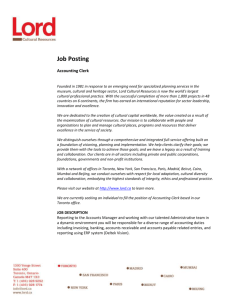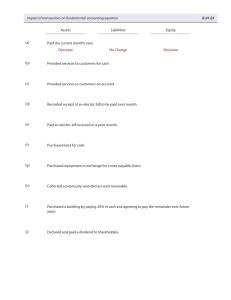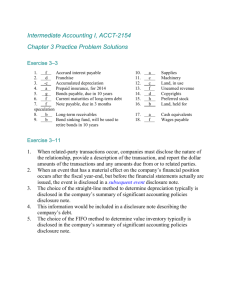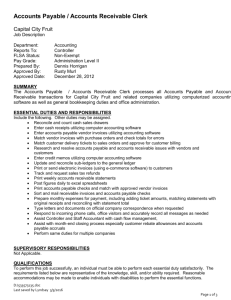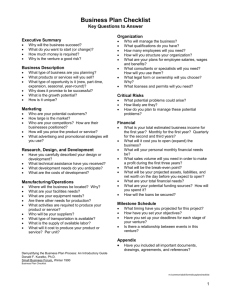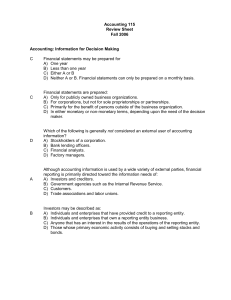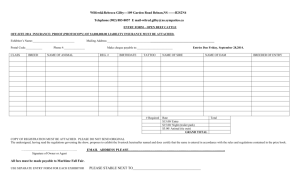Advanced Accounting Solution Manual Antonio J. Dayag Chapter 1
advertisement
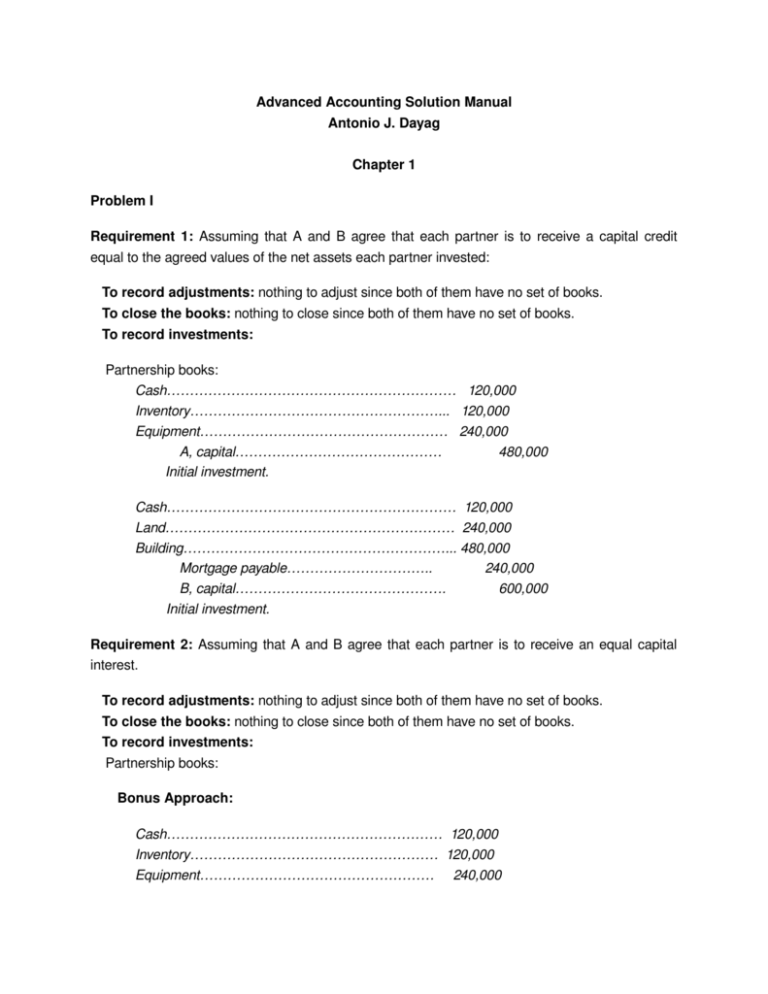
Advanced Accounting Solution Manual Antonio J. Dayag Chapter 1 Problem I Requirement 1: Assuming that A and B agree that each partner is to receive a capital credit equal to the agreed values of the net assets each partner invested: To record adjustments: nothing to adjust since both of them have no set of books. To close the books: nothing to close since both of them have no set of books. To record investments: Partnership books: Cash……………………………………………………… 120,000 Inventory………………………………………………... 120,000 Equipment……………………………………………… 240,000 A, capital……………………………………… 480,000 Initial investment. Cash……………………………………………………… 120,000 Land……………………………………………………… 240,000 Building…………………………………………………... 480,000 Mortgage payable………………………….. 240,000 B, capital………………………………………. 600,000 Initial investment. Requirement 2: Assuming that A and B agree that each partner is to receive an equal capital interest. To record adjustments: nothing to adjust since both of them have no set of books. To close the books: nothing to close since both of them have no set of books. To record investments: Partnership books: Bonus Approach: Cash…………………………………………………… 120,000 Inventory……………………………………………… 120,000 Equipment…………………………………………… 240,000 A, capital……………………………………… 480,000 Cash…………………………………………………… 120,000 Land…………………………………………………… 240,000 Building………………………………………………… 480,000 Mortgage payable………………………. 240,000 B, capital.…………………………………. 600,000 B, capital……………………………………………… 60,000 A, capital……………………………………. 60,000 Total agreed capital (P480,000 + P600,000)….P 1,080,000 Multiplied by: Capital interest (equal)……….. 1/2 Partner’s individual capital interest………… P 540,000 Less: A’s capital interest………………………. 480,000 Bonus to A…….…………………………………….P 60,000 Revaluation (Goodwill) Approach: Cash…………………………………………………………………………… 120,000 Inventory……………………………………………………………………… 120,000 Equipment……………………………………………………………………. 240,000 A, capital…………………………………………………………….. 480,000 Cash…………………………………………………………………………… 120,000 Land……………………………………………………………………………. 240,000 Building………………………………………………………………………... . 480,000 Mortgage payable………………………………………………… 240,000 B, capital.……………………………………………………….…… 600,000 Assets (or goodwill or intangible asset)…………………………………... 120,000 A, capital…………………..……………………………………….. 120,000 Total agreed capital (P600,000 / 1/2)………..….P1,200,000 Less: Total contributed capital (P480,000 + P 600,000)………………………………....… 1,080,000 Goodwill to A……………..………………………….P 120,000 Problem II Invested by John P100,000 100,000 ­ ­ ­ P100,000 Agreed Fair Values Cash Equipment Total assets Note payable assumed by partnership Net assets invested Invested by Jeff ­ ­ ­ P 110,000 P 110,000 30,000 P 80,000 Invested by Jane ­ ­ ­ ­ ­ ­ 0 ­ ­ ­ P 0 1. Bonus Method 2. Goodwill Method (Revaluation of Asset) Cash Equipment Note Payable Cash Equipment Goodwill Note Payable 100,000 110,000 John, Capital Jeff, Capital Jane, Capital 30,00 0 60,00 0 60,00 0 60,00 0 100,000 110,000 90,000 30,000 John, Capital 90,000 Jeff, Capital 90,000 Jane, Capital 90,000 2. The bonus method is used when John and Jeff recognize that Jane is bringing something of value to the firm other than a tangible asset, but they do not want to recognize an intangible asset. To equalize the capital accounts, P40,000 is transferred from John's capital account and P20,000 is transferred from Jeff's capital account. The goodwill method is used when the partners recognize the intangible nature of the skills Jane is bringing to the partnership. However, the capital accounts are equalized by recognizing an intangible asset and a corresponding increase in the capital accounts of the partners. Unless the intangible asset can be specifically identified, such as a patent being invested, it should not be recognized, because of a lack of justification for goodwill in a new business. Problem III 1. (a) Cash Accounts Receivable Office Supplies Office Equipment Accounts Payable Tom, Capital 13,000 8,000 2,000 30,000 2,000 51,000 (b) (c) 2. Cash Accounts Receivable Office Supplies Land Accounts Payable Mortgage Payable Julie, Capital 12,000 6,000 800 30,000 Tom, Drawing Cash 15,000 Julie, Drawing Cash 12,000 Income Summary Tom, Capital P50,000 × (P51,000/P76,000) Julie, Capital P50,000 × (P25,000/P76,000) 50,000 Tom, Capital Julie, Capital Tom, Drawing Julie, Drawing 15,000 12,000 5,000 18,800 25,000 15,000 12,000 33,553 16,447 15,000 12,000 TOM AND JULIE PARTNERSHIP Statement of Changes in Partners' Capital For the Year Ended December 31, 20x4 Capital balances, Jan. 1 Add: Additional investments Net income allocation Totals Less: Withdrawals Capital balances, Dec. 31 Problem IV Tom P 0 51,000 33,553 P 84,553 15,000 P 69,553 Julie P 0 25,000 16,447 P 41,447 12,000 P 29,447 Total P 0 76,000 50,000 P126,000 27,000 P99,000 Book of H is to be retained by the new partnership. The following procedures are to be followed: Individual versus Sole Proprietor Books of Individual N/A N/A *Books of Sole Proprietor Yes No Yes** Yes Adjusting entries Closing entries (real accounts) Investments Balance Sheet * Books of H; Partnership books ** Investments of individual; additional investments or withdrawals of sole proprietor. 1. Books of Sole Proprietor (H): a. To record adjustments: a. H, capital………………………………………………………………… 1,800 Allowance for doubtful accounts……………………………. 1,800 Additional provision computed as follows: Required allowance: 10% x P48,000 = P 4,800 Less: Previous balance………………… 3,000 Additional provision…………………… P 1,800 b. Interest receivable or accrued interest income…………………. 3,600 H, capital…………………………………………………………… 3,600 Interest income for nine months computed as follows: P60,000 x 8% x 9/12 = P3,000. c. H, capital………………………………………………………………….. 6,000 Merchandise inventory………………………………………….. 6,000 Decline in the value of merchandise. P27,000 – P21,000 = P6,000. d. H, capital…………………………………………………………………. 4,800 Accumulated depreciation……………………………………. 4,800 Under depreciation. e. Prepaid expenses………………………………………………………... 2,400 H, capital…………………………………………………………… 2,400 Expenses paid in advance. H, capital…………………………………………………………………… 7,200 Accrued expenses…………………………………………………. 7,200 Unrecorded expenses. Note: All adjustment that reflects nominal accounts should be coursed through the capital account, since all nominal accounts are already closed at the time of formation. b. To close the books: nothing to close since the books of H will be retained. c. To record investment: Cash……………………………………………………………………………. 116,100 I, capital……………………………………………………………… 116,100 Initial investment computed as follows: Unadjusted capital of H………………………………P 246,000 Add (deduct): adjustments: a. Doubtful accounts...……………………...( 1,800) b. Interest income…………………………….. 3,600 c. Decline in the value of merchandise….( 6,000) d. Under­depreciation……………………….( 4,800) e. Prepaid expenses………………………….. 2,400 Accrued expenses………………………...( 7,200) Adjusted capital balance of H……………..……...P 232,200 Divided by: Capital interest of H…………………… 2/3 Total agreed capital…………………………….…….P 348,300 Multiplied by: Capital interest of I……………..…… 1/3 Investment of I…………………………………………P 116,100 Note: The initial investment of H is already recorded since his books are already retained. No further entry is required since there are no additional investments or withdrawals made by H. 2. The balance sheet for both cases presented above is as follows: HI Partnership Balance Sheet November 1, 20x4 Assets Cash Accounts receivables Less: Allowance for doubtful accounts………........... Notes receivable……................................................... Interest receivable……………….................................. Merchandise Inventory................................................ Prepaid expenses………….......................................... P 48,000 4,800 P 236,100 43,200 60,000 3,600 21,000 2,400 Equipment (net)…………............................................. Less: Accumulated depreciation………………........ Total Assets.................................................................... P 72,000 10,800 61,200 P 427,500 Liabilities and Capital Liabilities Accrued expenses…….. ....................................... Accounts payable................................................... Notes payable…………........................................... Total Liabilities................................................................ Capital........................................................................... H, capital……………………….................................. I, capital…………………........................................... Total Capital.................................................................. Total Liabilities and Capital.......................................... P 7,200 12,000 60,000 P 79,200 P 232,200 116,100 P 348,300 P 427,500 Problem V New set of books. The following procedures are to be followed: Sole Proprietor versus Sole Proprietor Adjusting entries Closing entries (real accounts) Investments Balance Sheet Books of Sole Proprietor (Baker) Yes Yes Books of Sole Proprietor (Carter) Yes Yes *New Set of Books Yes** Yes * Partnership books ** Additional investments or withdrawals of sole proprietors. 1. Books of Sole Proprietor a. To record adjustments: Books of J a. J, capital…………………………12,000 Merchandise Inventory…… 12,000 Worthless inventory. b. J, capital………………………… 7,200 Allowance for doubtful Accounts………………….. 7,200 Worthless accounts. Books of K a. Merchandise Inventory………… 6,000 K, capital……………………… 6,000 Upward revaluation. b. K, capital……….…………………. 3,000 Allowance for doubtful accounts……………………. 3,000 Additional provision. Required allowance: c. Rent receivable…………………12,000 J, capital……………………. 12,000 Income earned. e. J, capital………………………… 8,400 Office supplies………………. 8,400 Expired office supplies. f. J, capital………………………… 6,000 Accumulated depreciation ­ equipment……………… 6,000 Under­depreciated. h. J, capital…………………………. 1,800 Interest payable……………. 1,800 Interest expense from July 1 to October 1. P60,000 x 12% x 3/12 Unadjusted capital of J…….……….P 372,000 Add(deduct): adjustments: a. Worthless merchandise……..( 12,000) b. Worthless accounts………….( 7,200) c. Rent income……………….…. 12,000 e. Office supplies expense…….( 8,400) f. Additional depreciation……( 6,000) h. Interest expense………………( 1,800) Adjusted capital of J…………………P348,600 b. To close the books: 5% x P180,000…….. P9,000 Less: Previous Balance……….. 6,000 Additional Provision....…………P3,000 c. K, capital……………………………. 9,600 Salaries payable………………. 9,600 Unpaid salaries. d. Interest receivable…………………1,200 K, capital………….................. 1,200 Interest income from August 17 to October 1. P60,000 x 16% x 45/360 g. K, capital……………………………12,000 Accumulated depreciation­ Furniture and fixtures……… 12,000 Under­depreciated. i. Patent………………………………. 48,000 K, capital…………………….. 48,000 Unrecorded patent. Unadjusted capital of K..……………...P432,000 Add(deduct): adjustments: a. Merchandise revaluation…….. 6,000 b. Worthless accounts…………….( 3,000) c. Salaries…………….…….………..( 9,600) d. Interest income………………….. 1,200 g. Additional depreciation………( 12,000) h. Patent………….……….…………. 48,000 Adjusted capital of K….………………..P462,600 Books of J Allowance for doubtful accounts................................. 12,000 Accumulated depreciation – equipment…………………… 60,000 Accounts payable……………159,600 Notes payable………………… 60,000 Interest payable………………. 1,800 J, capital…….…………………. 348,600 Cash………………………… 90,000 Accounts receivable……. 216,000 Merchandise inventory…. 180,000 Office supplies……………. 24,000 Equipment…………………. 120,000 Rent receivable…………... 12,000 Close the books of J. Books of K Allowance for doubtful accounts................................. 9,000 Accumulated depreciation – furniture and fixtures ………. 36,000 Accounts payable……………. 120,000 Salaries payable………………. 9,600 K, capital…….…………………. 462,600 Cash…………………………. 54,000 Accounts receivable…….. 180,000 Notes receivable…………. 60,000 Interest receivable………... 1,200 Merchandise inventory….. 150,000 Furniture and fixtures.…….. 144,000 Patent………….……………. 48,000 Close the books of K.. 2. New Set of Books ­ To record investments: Cash………………………………………………………………. Accounts receivable………………………………………….. Merchandise inventory……………………………………….. Office supplies………………………………………………….. Equipment (net)………………………………………………... Rent Receivable……………………………………………….. Allowance for doubtful accounts……………………. Accounts payable……………………………………….. Notes payable……………………………………………. Interest payable………………………………………….. J, capital…………………………………………………… Cash………………………………………………………………. Accounts receivable………………………………………….. Notes receivable………………………………………………. Interest receivable…………………………………………….. Merchandise inventory……………………………………….. Furniture and fixtures (net)…..……………………………….. Patent…………..………………………………………………... Allowance for doubtful accounts……………………. Accounts payable……………………………………….. Salaries payable….………………………………………. K, capital…………………………………………………… 90,000 216,000 180,000 24,000 60,000 12,000 54,000 180,000 60,000 1,200 150,000 108,000 48,000 12,000 39,600 60,000 1,800 468,600 9,000 120,000 9,600 462,600 3. H P372,000 348,600 (P 23,400) Unadjusted capital (refer to 1a) Adjusted capital (refer to 1b) Net adjustments (debit)/credit I P432,000 462,600 P 30,600 4. The balance sheet after formation is as follows: J and K Partnership Balance Sheet October 1, 20x4 Assets Cash............................................................................... Accounts receivables ................................................. Less: Allowance for doubtful accounts………......... Notes receivable……................................................... Interest receivable……………….................................. Rent receivable………………....................................... Merchandise Inventory................................................ Office supplies............................................................... Equipment (net)…………............................................. Furniture and fixtures (net)…………………................. Patent……………………............................................... Total Assets.................................................................... Liabilities and Capital Liabilities Salaries payable……………................................... Accounts payable.................................................. Notes payable………….......................................... Interest payable…………….................................... Total Liabilities............................................................... Capital J, capital……………………….................................. K, capital…………………......................................... Total Capital.................................................................. Total Liabilities and Capital.......................................... Problem VI 1. Total assets – P1,094,000, at fair value 2. Total liabilities ­ P540,000, at fair value P396,000 21,000 P 144,000 375,000 60,000 1,200 12,000 330,000 24,000 60,000 108,000 48,000 P1,162,200 P 9,600 159,600 60,000 1,800 P 231,000 P 468,600 462,600 P 931,200 P1,162,200 3. Total capital ­ P554,000 (P1,094,000 – P540,000) Balance Sheet Assets January 1, 2009 Liabilities and Capital Cash P 70,000 Account Receivable (net) Merchandise Inventory Building (net) Furniture and Fixture (net) 108,000 208,000 600,000 108,000 Liabilities Accounts Payable Mortgage Payable Total Liabilities Capital: P 190,000 __350,000 P 540,000 Accounts Payable L, Capital P 260,000 Mortgage Payable M, Capital ___294,000 Total Assets _________ _ P1,094,00 0 Total Capital Total Liabilities and Capital P 554,000 P 1,094,000 Multiple Choice Chapter 1 1. c – P45,000 2. a – the prevailing selling price which is also the fair market value. 3. c Cash Property Mortgage assumed Equipment Amount credited to capital accounts The capital balances of each partner are determined as follows: Apple Blue Crown P50,000 P 80,000 (35,000) P 55,000 P50,000 P 45,000 P 55,000 4. c – (P190,000 – P160,000) x 1/2 = P15,000 5. d – the prevailing selling price which is also the fair market value. 6. a Total Agreed Capital (P50,000/40%)…………………………............... Less: Total Contributed Capital (P65,000 + P50,000)…….................. Goodwill (revaluation of assets upward)………………….................. P125,000 115,000 P 10,000 Assets, fair value (P20,000 + P60,000 + P15,000)…………………………P 95,000 Less: Liabilities assumed…………………………………………………..… 30,000 Bill, capital..…………………………………………………………………… P 65,000 7. b P330,000 = P50,000 + (P310,000 ­ P30,000) 8 . b The capital balances of William (WW) and Martha (MM) at the date of partnership formation are determined as follows: William Martha Cash P20,000 P 30,000 Inventory Building Furniture and equipment Total Less mortgage assumed by partnership Amounts credited to capital 9. c ­ ­ 15,000 P35,000 15,000 40,000 ­ P 85,000 P35,000 (10,000 ) P 75,000 Evan Helen Unadjusted capital Add (deduct) adjustments: 59,625 33,500 Allowance Depreciation Adjusted capital ( 555) ______ 59,070 ( 405) ( 900) 32,195 10. c: Jones – P80,000 + P400,000 – P120,00 = P360,000 Smith – P40,000 + P280,000 – P60,000 = P260,000 11. c – P35,374 – refer to No. 12 12. c – P17,687 Unadjusted capital of CC………………………………………………………………….P 33,000 Add (deduct): adjustments­ Allowance for doubtful accounts (3% x P14,200)………………………………...( 426) Increase in merchandise inventory (P23,000 – P20,000)………………………… 3,000 Prepaid salary………………………………………………………………………….... 600 Accrued rent expense…………………………………………………………………( 800) Adjusted capital balance of CC…………………………………………………………P 35,374 Divided by: Capital interest of CC…………………………………………………….... 2/3 Total capital of the partnership……………………………………………………………P 53,061 Less: Adjusted capital balance of CC………………………………………………….. 35,374 Capital balance of DD…………………………………………………………………….. P 17,687 13. a Total assets: Cash Machinery Building Less Liabilities (Mortgage payable) Net assets (equal to FF’s capital account) 14. d FF, capital (see no.13) P 70,000 75,000 225,000 P 370,000 90,000 P 280,000 P 280,000 Divide by FF’s P & L share percentage Total partnership capital Required capital of CC (P400,000 x 30%) Less Assets already contributed: Cash Machinery and equipment Furniture and fixtures Cash to be invested by CC 70% P 400,000 P 120,000 P 30,000 25,000 10,000 15. (a) Adjusted capital of LL (2/3): Unadjusted capital 65,000 P 55,000 P 158,400 Adjustments: Prepaid expenses Accrued expenses Allowance for bad debts (5% x P100,000) Adjusted capital 17,500 (5,000) (5,000) P 165,900 Total partnership capital (P165,900/2/3) Multiply by MM’s interest MM’s capital Less Merchandise contributed Cash to be invested by MM P 248,850 1/3 P 82,950 50,000 P 32,950 16. d Adjusted capital of LL Contributed capital of MM Total capital 17. a FF, capital: Unadjusted balance Adjustments: Accumulated depreciation Allowance for doubtful account Adjusted balance GG, capital: Unadjusted balance Adjustments: Accumulated depreciation P 165,900 82,950 P 248,850 P 57,000 ( 1,500) (12,000) P 43,500 P 49,500 ( 4,500) Allowance for doubtful account Adjusted balance ( 4,500) P 40,500 18. c GG’s adjusted capital (see no. 17) Divide by GG’s P & L share percentage Total partnership capital Multiply by FF’s P & L share percentage FF’s capital credit FF’s contributed capital (see no. 1) Additional cash to be invested by FF P 40,500 40% P 101,250 60% 60,750 43,500 P 17,250 19. d Total capital of the new partnership (see no. 20) Multiply by RR’s interest Cash to be invested by RR P 296,875 20% P 59,375 20. (a) Unadjusted capital balances Adjustments: Allowance for bad debts Inventories Accrued expenses Adjusted capital balances OO PP Total (60%) (40%) P133,000 P108,000 P241,000 ( 2,700) ( 1,800) ( 4,500) 3,000 2,000 5,000 ( 2,400) ( 1,600) ( 4,000) P130,900 P106,600 P237,500 Total capital before the formation of the new partnership (see above) Divide by the total percentage share of OO and PP (50% + 30%) Total capital of the partnership after the admission of RR 21. a OO PP Agreed Capital Contributed Capital P148,437.50 (50% x P296,875) P 130,900 89,062.50 (30% x P296,875) 106,600 P 237,500 80% P 296,875 Settlement P 17,537.50 (17,537.50) Therefore, OO will pay PP P17,537.50 22. c Total partnership capital (P113,640/1/3) Less DD’s capital CC’s capital after adjustments Adjustments made: P 340,920 113,640 P 227,280 Allowance for doubtful account (2% x P96,000) Merchandise inventory Prepaid expenses Accrued expenses CC’s capital before adjustments 1,920 ( 16,000) ( 5,200) 3,200 P 211,200 23. a Assets invested by CC: Cash: Capital P211,200 Add Accounts payable 49,600 Total assets (excluding cash) 260,800 Less Noncash assets (96,000 + P144,000) 240,000 P20,800 Accounts receivable (96,000 – P1,920) 94,080 Merchandise inventory 160,000 Prepaid expenses 5,200 Cash invested by DD Total assets of the partnership P 280,080 113,640 P 393,720 24. d Total partnership capital (P180,000/60%) P 300,000 GG’s Capital (P300,000 x 40%) Less Cash investment Merchandise to be invested by GG P 120,000 30,000 P 90,000 25. a Adjusted capital of JJ: Total assets (at agreed valuations) Less Accounts payable Required capital of JJ Cash to be invested by JJ P 180,000 48,000 P 132,000 180,000 P 48,000 Theories 1. d 6. a 11. a 16. c 2 . 3 . 4 . 5 b 7. c 12. c 17. b c 8. a 13. b 18. b A 9. d 14. c B 10, b 15, d .

